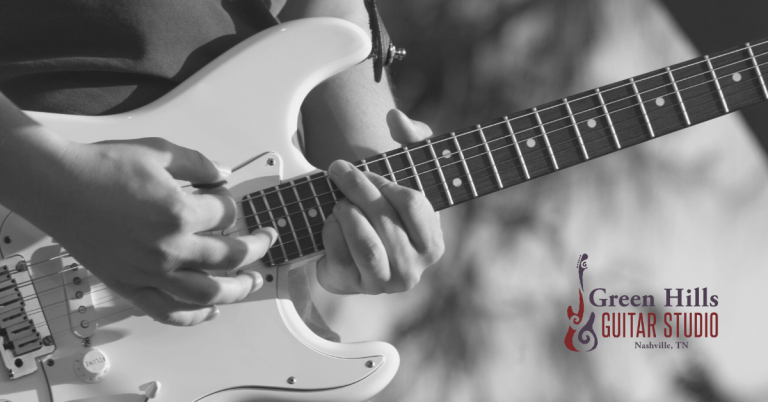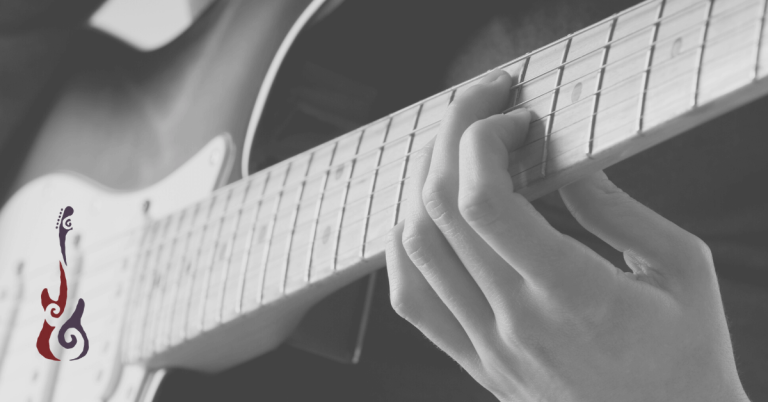Intervals Made Easy: A Guitarist’s Guide to Understanding Intervals
Curious about what makes your favorite guitar solos and riffs so memorable? It all starts with understanding intervals—a fundamental yet often overlooked concept that can transform your playing. Intervals are the building blocks of chords, melodies, and harmony—and they’re easier to grasp than you might think. In this guide, we’ll break down what intervals are, why they’re essential, and how you can use them to help you improve your playing.
What Are Intervals?
An interval is simply the distance between two notes. Think of it like the steps on a staircase—each step represents a specific distance, whether it’s small (a half step) or larger (a whole step). For instance, the distance between two adjacent frets on a guitar is a half step, similar to moving one step up or down on a staircase. This distance is measured in steps (whole or half) and expressed numerically (2nd, 3rd, etc.). Understanding intervals allows you to:
- Build chords from scratch.
- Recognize and play melodies by ear.
- Navigate the fretboard with confidence.
The Basics of Intervals
Intervals are categorized into two main types:
- Harmonic intervals: Two notes played simultaneously. For example, play the 5th fret on the D string and the 5th fret on the G string together to hear a harmonic interval.
- Melodic intervals: Two notes played sequentially. For instance, pluck the 5th fret on the D string and then the 7th fret on the same string to create a melodic interval.
Here are the basic intervals you’ll encounter:
Unison (1st)
- Two identical notes. On the guitar, this is the same fret on adjacent strings (e.g., the 5th fret on the D and G strings).
Minor Second (m2)
- A half step apart. Think of the opening notes of “Jaws.” On the guitar, this is one fret difference on the same string.
Major Second (M2)
- A whole step apart. This interval is two frets on the same string.
Minor Third (m3)
- Three half steps apart. It creates a darker, sadder sound. Think of the opening of “Greensleeves.”
Major Third (M3)
- Four half steps apart. This interval defines major chords and has a bright, happy tone.
Perfect Fourth (P4)
- Five half steps apart. It’s a staple in rock riffs and provides a sense of movement and tension resolution when used in melodies and chord progressions.
Tritone (TT)
- Six half steps apart. This interval has a tense, unresolved sound and is prominent in blues and jazz.
Perfet Fifth (P5)
- Seven half steps apart. Think power chords and the iconic opening of “Smoke on the Water.” The fifth degree is associated with the dominant chord.
Minor Sixth (m6)
- Eight half steps apart. This interval feels melancholy and is often used in jazz ballads.
Major Sixth (M6)
- Nine half steps apart. It has a warm, expansive quality.
Minor Seventh (m7)
- Ten half steps apart. This interval forms the foundation of minor seventh chords.
Major Seventh (M7)
- Eleven half steps apart. It has a dreamy, jazzy feel.
Octave (8ve)
- Twelve half steps apart. It’s the same note but at a higher pitch.
Why Intervals Matter
- Build Chords: Chords are constructed by stacking intervals. For example, a major triad consists of a root, a major third, and a perfect fifth.
- Shape Melodies: Melodies are sequences of intervals. Recognizing intervals helps you play by ear and improvise.
- Improve Fretboard Navigation: Understanding intervals allows you to see patterns on the guitar neck, making it easier to shift between positions.
Intervals Across the Fretboard
Let’s explore how intervals appear on the guitar.
Same String
- Minor Second: Move up one fret.
- Major Second: Move up two frets.
- Minor Third: Move up three frets.
- Major Third: Move up four frets.
Adjacent String (Standard Tuning)
- Perfect Fourth: Same fret on the lower and higher strings.
- Major Third: One fret back on the higher string (e.g., 5th fret on the D string, 4th fret on the G string).
- Minor Third: Two frets back on the higher string.
*Note that the frets change between the 3rd string (G) and the 2nd string (B) because the B string is tuned a major third higher than the G string. In standard tuning, all other strings are tuned a perfect fourth higher than the string before them.
Practice Tip: Use simple shapes to learn intervals. For example, play the root note and its interval on adjacent strings, then repeat across the fretboard.
Practice Exercises
Here are three exercises to help you internalize intervals.
Exercise 1: Interval Identification
- Play a root note on the low E string, such as the 3rd fret (G).
- Play an interval (e.g., a major third) above the root by moving to the 7th fret (B) on the same string.
- Say the interval name out loud as you play.
- Repeat this for all strings.
Exercise 2: Ear Training
- Play two notes and identify the interval by ear.
- Start with simple intervals like unison, perfect fifths, and octaves.
- Gradually work up to more complex intervals like minor 7ths and tritones.
Exercise 3: Building Chords with Intervals
- Choose a root note.
- Stack intervals to form a chord (e.g., root + major third + perfect fifth = major chord).
- Play the chord across different positions on the fretboard.
Using Intervals in Music
Intervals are the key to creating variety and depth in your playing. Here’s how:
Compose Melodies
Intervals can add emotion to your melodies. For example:
- Use major intervals for uplifting, happy melodies.
- Use minor intervals for somber, introspective tones.
Add Color To Your Chords
- Experiment with adding intervals like 7ths, 9ths, or 11ths to basic chords for richer harmonies.
Improvise Solos
- Think in intervals rather than scales or modes to create more intentional, melodic solos.
The Coda
Ready to take your guitar playing to the next level? At Green Hills Guitar Studio in Nashville, we offer personalized instruction tailored to your unique goals and skill level.
Our expert teachers focus on practical techniques and music theory, empowering you to build confidence and express yourself fully on the guitar.
Whether you’re a beginner or an advanced player, our tailored guitar lessons will help you achieve your goals. Contact us today to start learning the secrets of the fretboard.






